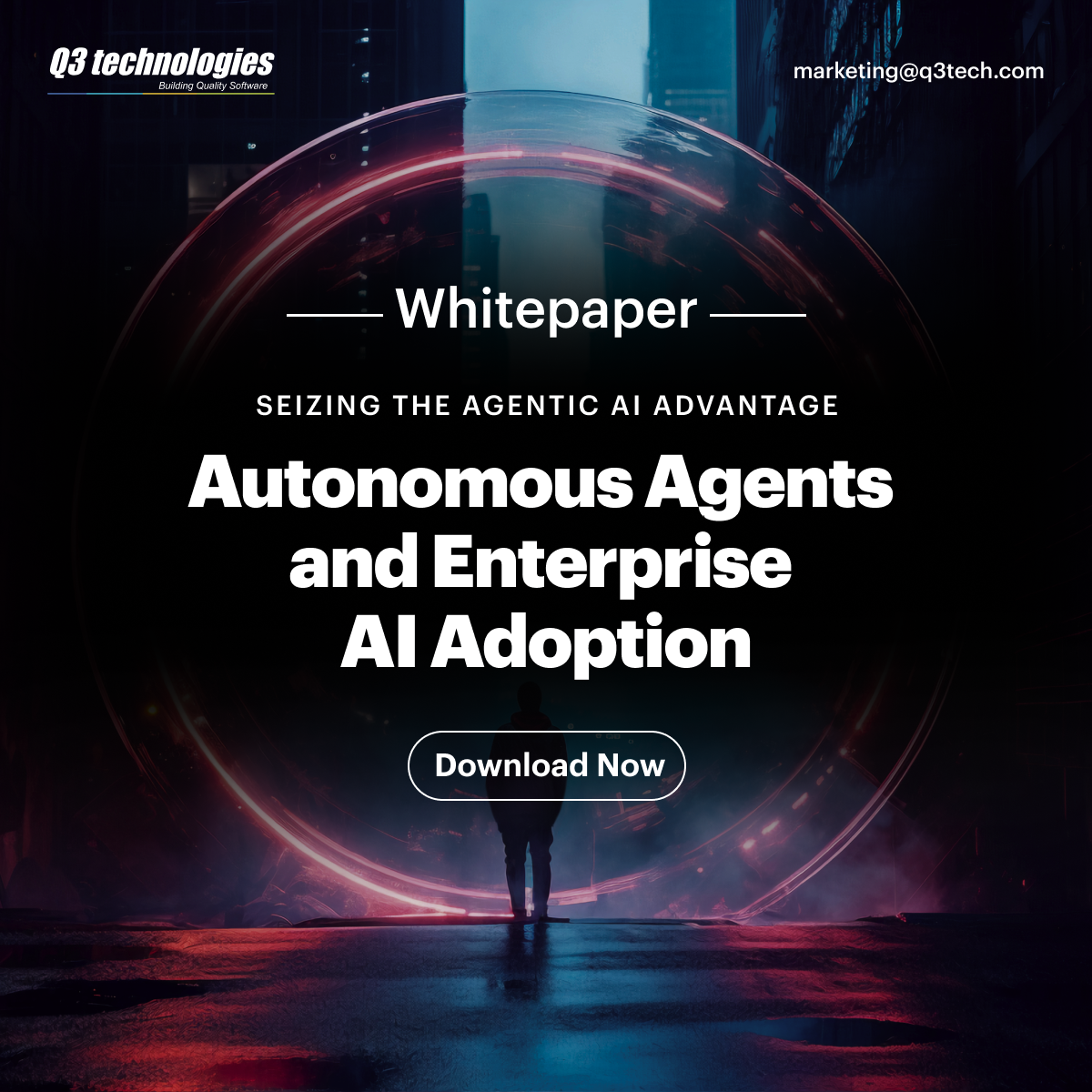Technology
How Spatial Technology is Powering the Next Wave of Q-Commerce
 Updated 10 Jul 2025
Updated 10 Jul 2025

Quick commerce, or Q-commerce, is rapidly transforming the digital retail landscape by enabling ultra-fast deliveries, often within 10 to 30 minutes. As consumer expectations continue to evolve, this need for immediacy is putting immense pressure on supply chains, technology systems, and last-mile delivery models. According to Statista, the global Q-commerce market was valued at approximately $60 billion in 2024, and it is projected to cross $150 billion by 2027, driven by urbanization and changing consumer behavior.
Behind this growth lies a significant enabler — spatial technology. This emerging tech is empowering Q-commerce delivery platforms by providing real-time geographic insights, enhancing delivery speed, and optimizing route efficiency. Combined with mobile app development and AI-powered logistics, spatial information technology is fueling a new era of digital commerce, where location is the key to speed.
E-Commerce vs Q-Commerce: The Race for Speed and Efficiency
To understand the impact of spatial technology, it’s essential to differentiate between e-commerce vs Q-commerce. Traditional e-commerce focuses on variety, price, and convenience with delivery windows ranging from same-day to several days. In contrast, Q-commerce prioritizes speed and hyperlocal delivery, catering to impulse purchases, essentials, and urgent needs.
While e-commerce relies on regional or centralized warehouses, Q-commerce depends on dark stores or micro-fulfillment centers strategically placed in urban locations. This is where location-based technology becomes indispensable, helping businesses identify optimal store locations, monitor real-time inventory, and improve delivery coordination.
How Spatial Technology Works in Delivery Operations
Spatial technology refers to systems and tools that capture, analyze, and interpret data related to the Earth’s surface. These include Geographic Information Systems (GIS), GPS, remote sensing, and location-based analytics. In delivery operations, spatial technology in delivery enables real-time route planning, geofencing, location tracking, and customer address verification.
For Q-commerce platforms, these capabilities are crucial. From deciding where to open a dark store to assigning the closest delivery agent, spatial information technology powers real-time decision-making and predictive delivery algorithms, drastically improving customer experience and operational efficiency.
Boost Your Q-Commerce with Spatial Intelligence
Build smarter, faster delivery systems with Q3 Technologies.
Use of Spatial Technology in Q-Commerce Delivery Infrastructure
The integration of spatial technology into Q-commerce delivery infrastructure is not just an add-on — it’s a core foundation. Here’s how it contributes:
- Optimized Warehouse Placement: Spatial analysis helps businesses pinpoint ideal locations for dark stores based on delivery density, traffic patterns, and consumer demand.
- Dynamic Dispatching: Real-time mapping allows delivery management systems to assign the nearest available rider, reducing response time.
- Geo-fencing and Tracking: With location-based technology, platforms can create delivery zones, monitor field agents, and offer customers real-time delivery tracking.
- Address Intelligence: It improves geocoding accuracy, ensuring deliveries reach the right place — even in densely populated urban zones with complex layouts.
By deploying spatial technology in delivery, Q-commerce brands can reduce average delivery time, cut logistics costs, and increase customer satisfaction.
Smart Delivery Routing with Spatial Insights
One of the most significant benefits of spatial technology is its role in smart delivery routing. Q-commerce thrives on speed, and shaving even a few minutes off a route can lead to substantial cost savings and better service.
Smart delivery routing powered by route optimization software ensures:
- Shortest Time & Distance: AI models analyze traffic conditions, roadblocks, and delivery windows to find the fastest routes.
- Real-Time Re-Routing: If a delay or blockage occurs, the system dynamically recalculates the optimal path.
- Batch Optimization: Multiple orders can be clubbed and assigned to a single route with minimal deviation.
Such intelligent routing directly improves quick commerce logistics, ensuring goods arrive faster while reducing fuel and labor costs — a crucial need for profitability in hyperlocal delivery models.
Mobile App Development for Real-Time Q-Commerce Visibility
In today’s always-connected world, mobile app development is central to Q-commerce operations. Whether it’s a delivery partner tracking their route or a customer checking real-time updates, eCommerce app development with spatial capabilities adds immense value.
A well-designed mobile app:
- Integrates spatial information technology for real-time driver tracking.
- Notifies customers about live delivery status with ETAs based on route analytics.
- Offers visualizations like maps and drop-point accuracy.
- Provides delivery partners with smart navigation and route updates.
At Q3 Technologies, we specialize in mobile app development with seamless spatial integration, ensuring Q-commerce businesses offer fast, frictionless, and transparent delivery experiences.
Develop Smart Q-Commerce Apps
Enhance real-time tracking and routing with spatial-powered mobile apps.
Spatial Technology and Logistics Software Development: A Perfect Match
As the Q-commerce industry evolves, so does the need for robust backend systems. This is where logistics software development intersects with spatial technology. Together, they automate, optimize, and scale the most complex parts of delivery operations.
Key features of spatial-enabled logistics software include:
- Inventory Location Mapping across multiple dark stores.
- Geo-intelligent Order Allocation based on proximity and capacity.
- Fleet Monitoring and route deviation alerts.
- Analytics Dashboards with heatmaps of delivery activity.
Partnering with the right software development company ensures these features are tailored to your operational workflows. At Q3 Technologies, we build scalable, custom logistics platforms that empower Q-commerce brands with smart routing, spatial data insights, and real-time control.
Case Study: Transforming Delivery Models with Spatial Tech
A leading Q-commerce startup approached Q3 Technologies to reduce delivery time in congested metro areas. They faced challenges such as inefficient route planning, high fuel costs, and poor real-time tracking. We implemented a solution that integrated:
- Spatial technology in delivery via a GPS-powered backend.
- AI-based route optimization software for smart dispatching.
- A customer-facing mobile app with real-time tracking.
- Analytics dashboards for location heatmaps and delivery KPIs.
The results:
- 23% reduction in delivery time.
- 18% improvement in on-time delivery rate.
- 30% decrease in operational costs.
This case underscores how spatial technology can be a game-changer in quick commerce logistics.
Future Outlook: Spatial Technology as the Backbone of Instant Commerce
As cities grow denser and consumer demands get sharper, spatial technology will continue to be the backbone of instant commerce. The future of enterprise IT operations in Q-commerce will rely on:
- Hyperlocal fulfillment centers powered by location data.
- AI agents using geospatial intelligence for real-time decisions.
- Advanced drone and autonomous vehicle routing.
- Predictive delivery models based on heatmaps and trends.
This shift means spatial technology is not just a support tool — it’s becoming an integral part of enterprise agentic AI platforms, where decision-making and automation are driven by contextual location intelligence.
Choosing the Right Software Development Company for Q-Commerce Solutions
At Q3 Technologies, we are a trusted partner for brands navigating the Q-commerce revolution. Our team delivers cutting-edge software development, enriched with spatial insights, AI, and real-time data architecture.
To fully leverage spatial technology, businesses need more than just tools — they need expertise. Choosing a reliable software development company ensures your spatial-enabled Q-commerce solutions are not only functional but also scalable and secure.
Here’s what to look for:
- Proven experience in eCommerce app development.
- Expertise in integrating location-based technology.
- End-to-end support from AI Development Services to mobile app development.
- Customizable solutions for your unique logistics workflows.
Optimize Your Logistics Operations
Streamline routes and reduce costs with custom logistics solutions.
Conclusion
Q-commerce is no longer a novelty — it’s the new norm. But to stay competitive, businesses must evolve beyond basic logistics and embrace intelligent, location-aware ecosystems. By integrating spatial technology, mobile app development, and logistics software development, brands can streamline their Q-commerce delivery, boost performance, and deliver superior customer experiences.
At Q3 Technologies, we help businesses tap into the full potential of spatial information technology to build smart, scalable, and agile Q-commerce platforms. Whether you’re just starting or scaling up, let spatial intelligence be your edge in the fast-paced race of modern commerce.
FAQs
What is Spatial Technology?
Spatial technology refers to tools and systems like GPS, GIS, and remote sensing that collect, analyze, and interpret location-based data. In Q-commerce, it helps optimize delivery routes, track orders in real time, and enhance location intelligence.
How will Q-Commerce evolve in India’s hyperlocal delivery ecosystem?
Q-Commerce in India is expected to grow rapidly with the rise of dark stores, micro-fulfillment centers, and the integration of spatial technology. Faster deliveries, real-time tracking, and AI-driven logistics will redefine the hyperlocal experience.
How big is the Q-Commerce & hyperlocal delivery market in India?
As of 2024, India’s Q-commerce and hyperlocal delivery market is valued at over $3.5 billion and is projected to grow exponentially, driven by urbanization, mobile-first users, and demand for instant delivery.
What is the Q-Commerce & hyperlocal delivery ecosystem?
The Q-commerce and hyperlocal delivery ecosystem includes fast-moving consumer goods delivery services, dark stores, last-mile logistics, and mobile apps that fulfill orders within 10–30 minutes using real-time location-based technologies.
Which e-commerce platform is positioned as a key competitor in Q-Commerce?
Platforms like Blinkit, Zepto, Swiggy Instamart, and BigBasket’s BB Now are leading Q-commerce players in India, competing on speed, inventory availability, and location optimization.
Which regions dominate the Q-commerce market?
Urban metro regions like Delhi NCR, Mumbai, Bengaluru, and Hyderabad dominate the Q-commerce market due to dense populations, high demand for instant delivery, and better logistics infrastructure.
Table of Content
- E-Commerce vs Q-Commerce: The Race for Speed and Efficiency
- How Spatial Technology Works in Delivery Operations
- Use of Spatial Technology in Q-Commerce Delivery Infrastructure
- Smart Delivery Routing with Spatial Insights
- Mobile App Development for Real-Time Q-Commerce Visibility
- Spatial Technology and Logistics Software Development: A Perfect Match
- Case Study: Transforming Delivery Models with Spatial Tech
- Future Outlook: Spatial Technology as the Backbone of Instant Commerce
- Choosing the Right Software Development Company for Q-Commerce Solutions
- FAQs



